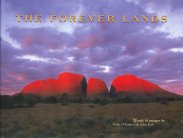Thylazine: The Australian Journal of Arts, Ethics & Literature #9/thyla9f-mobook
AUSTRALIAN POETRY BOOK REVIEWS
The Forever Lands by John Kirk and Mark OConnor
(Beyond Images, Camberwell East, VIC, Australia, 2000, ISBN: 0-646-39609-9, $29.95)

|
On the surface, this is what would be called in the U.S. a "coffee table book". It's handsomely done, a real crowd pleaser. The arresting image on the front cover, that of Kata Tjuta in the Olgas, would entice anyone to open this book and discover the aesthetic rewards inherent in the format. But the format is not merely created for display. Not at all. Despite the glossy surface, something sly and mercurial is at work here. And I'm glad of it. The last thing I want to see in a book is Australia all prettied-up, fit only for postcards. |
What Kirk and O'Connor intend is a graceful interplay of text and image, a counterpoint. Kirk provides the photos, O'Connor is the poet. And they succeed brilliantly. A sense of light, air, and liquidity is established in the juxtaposition of images and text. The reader's eye begins to pick up what is hard or soft, the slope of a rock as it changes at certain times of day, or the minute movements of a bird. Wave of a flower. Images repeat, such as that of Nemargon, the Grasshopper Man. Skies loom, water rushes, and there's even a view from inside a cave, looking out ... reminding us, we're all visitors here. I can almost feel the warmth of sunlight on rocks, or the sting of wind.
And what makes me appreciate this book even more is that I've just come back from England, having been there for the first time. "Go to Hampstead," my London friends said, raving about its beauty. Hampstead Heath! Hampstead Heath! What the hell, Hampstead is a suburb. The Heath? Pretty, but so what. Give me land that has wildness to it. Land that coils, undulates, causes my heart to beat faster. What is - er - Hampstead - to the Grampions? Apollo Bay? An ordered miniature next to the stamp of God. Or the gods. Being in England made me truly miss Australia. The irritating rows of terrace houses in London had me longing for Sydney's open spaces, its clean smell, its pull to oceanic waves. And as an American, the red rocks of The Forever Lands also remind me of the vast panoramas of the American West. Unsentimental, gritty land. Winds that can slap as well as caress.
Because The Forever Lands deals with wild places in the Northern Territory, and not urban Australia, a tendency to mythologize is strong. "The Dreamtime was true./ Those rocks all lived./ The land was alive and convulsing when seas were hot mists." (from 'Dinosaur Dreaming'). Sometimes it works, and sometimes it doesn't. Often the poems will describe surfaces in a colourful way, but without the sharper poetic tensions that would convey real danger, or upheaval. Even violence. We, as readers, remain spectators. All of us in perpetual wonder. Perhaps Mark O'Connor intends us to stand back a bit, and merely witness the procession of images, feeling that words can only give a taste of that remote beauty, that feast for the senses. At any rate, he's best with details, as in this passage from 'Nemargon, the Lightning Grasshopper.'
"The grasshopper chirrups,
in two or three places,
his strident song of Nemargon
whetting his stone. One vibrant messenger
to each valley. Pluck him
out of his chosen tussock
- you grasp the cyclone in your hand."
Most of the poems are strongly visual, with vivid imagery, and verbs doing the work that mere description cannot accomplish. There's a lot of movement: birds leap, water churns, insects and animals glide on the ground. Nothing in the landscape is at rest, completely still - although from a distance, it might look that way. 'At Edith Falls' is a poem lovely in its eroticism, a place where "the honeyeater finds its tribe/ among golden nectar-dripping cones."
It's a place where sexuality is expressed in a natural, graceful way. "He calls to the girl/ who sits hugging her lack of bra./ She dives - idling out with a frog kick,/ her whiteness dissolving in ripples."
Not all the poems work. 'Jabirus at Anabangbang' is much too descriptive and prosaic or prose-like. 'A Quokkle of Pelicans' is just plain flat, with its lame metaphor of pelicans as "conference delegates". And the tribute to Aboriginal traditions also turns prosaic, like something learned, without spontaneity in language.
On the whole, though, this book is delightful. A volume to keep in one's library for years, and buy for friends. The poem 'Rock Altar' is a perfect expression of the book's main theme: a reverence for nature, its ability to influence the human soul. Here is the concluding stanza.
"A night wind writes on the sand,
its brush slowly deepening ripples
to last a week.
Scrawlings of bush rat and skink
have only two texts:
Be humbled by your irrelevance;
Rejoice that the world admits you.
Both texts are the same text."
(Reviewed by Sharon Olinka, March 2004)
I Next I
Back I
Exit I
Thylazine No.9 (March, 2004) | |



